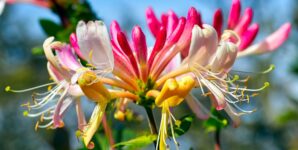
How to Grow and Care for a Honeysuckle Bush
Honeysuckle is a fast-growing vining plant that can cover a trellis or garden arbor with shiny green foliage and fragrant tubular-shaped flowers. In late spring and early summer, its sweet scent wafts in the breeze, making it ideal for adding another layer of enjoyment to your garden. Some types bloom later in the season, too.
Honeysuckle (Lonicera spp.) attracts lots of different pollinators, especially hummingbirds. It has few pests, making it a low-maintenance beauty for most gardens. Honeysuckle grows in USDA Hardiness Zones 4 to 10 (find your zone here), so it can thrive across much of the country. Depending on the variety, honeysuckle can reach six to 20 feet tall.
But be aware that there are many types of honeysuckle, including some that are invasive and should never be planted in your garden. The key to distinguishing between types is reading the plant label or description: Common honeysuckle (Lonicera periclymenum) and trumpet honeysuckle (Lonicera sempervirens), native to the east and southeast, are good choices for most gardens.
Read on to learn how to grow and care for a honeysuckle bush to enjoy its bewitching fragrance all season long.
How to Grow Honeysuckle
Honeysuckle is a low-maintenance plant once established. It provides a pretty vertical accent to your garden and attracts pollinators, helping their populations thrive. In the South, honeysuckle bushes may be evergreen; in the rest of the country, honeysuckle is deciduous, shedding its leaves in fall.
Light
Honeysuckle needs full sun, which is considered 6 or more hours of direct sunlight per day. Although it tolerates some light shade, it blooms best with full sun conditions.
Soil
Honeysuckle prefers well-draining, rich soil, but it can adapt to many soil types and pH levels. However, it does not like soggy soil or areas with standing water.
Watering
Honeysuckle is drought-tolerant once established. Water well for several weeks after planting and during very dry conditions (when you haven’t received rain for a few weeks). A two- to three-inch-deep layer of mulch will help retain moisture and keep down competing weeds.
Fertilizer
For best blooms, you can add compost or slow-release granular fertilizer once in the spring.
Types of Honeysuckle
Many types of honeysuckle cultivars, or cultivated varieties, have been bred. Read the plant tag to understand what you’re buying because not all types are fragrant. The description will also tell you the plant’s size at full maturity.
- ‘Scentsation’ (Lonicera periclymenum): Showy yellow flowers from mid-spring to summer; excellent fragrance; grows eight to 10 feet tall.
- ‘Major Wheeler’ (Lonicera sempervirens): Lots of red or coral flowers from late spring to summer—a hummingbird favorite; red berries attract birds in the fall; reaches five to seven feet.
- ‘Goldflame’ (Lonicera x heckrottii): Gorgeous pink and yellow flowers from summer to fall, followed by red berries; attractive to hummingbirds; fragrant; grows up to 15 feet tall.
- ‘Peaches and Cream’ (Lonicera periclymenum): Fragrant, peach-colored flowers; compact variety reaches six feet tall.
How to Get Honeysuckle to Bloom
Honeysuckle does not need to be babied and blooms profusely once established. However, it can take several years for the plant to take off after first planted, so be patient. Make sure it is receiving full sun (six or more hours of direct sunlight), otherwise, it will produce few flowers.
How to Propagate Honeysuckle
First, make sure the plant is not a patented cultivar (with a patent number or PPAF listed on the tag), which makes it illegal to cultivate. If not, then take a six-inch cutting of a firm but flexible stem. Remove the lower leaves, dip the cut end in rooting hormone, and then place in moist potting mix. Water well, and keep in a brightly lit spot that’s out of direct sunlight. The cutting should take several weeks to root.
Pruning Honeysuckle
It is usually not necessary to prune a honeysuckle bush, but if you must neaten it up, trim it back to shape it immediately after flowering. It’s also fine to trim off dead pieces anytime during the growing season.
Common Problems With Honeysuckle
Fortunately, honeysuckle bushes are not prone to pests or diseases. Occasionally, you may see aphids, but you can blast them off with a garden hose. Four-lined plant bugs also may affect plant leaves, leaving sunken brown spots on the leaves, though they typically don’t affect the vigor of the plant.
Honeysuckle FAQs
Can You Grow Honeysuckle in Pots?
You can definitely grow honeysuckle in pots. However, you will need a very large container and a trellis to support the plant. As it grows, the pot may become top-heavy and topple over. For this reason, it’s typically best to grow these plants in landscape beds, when possible.
Is Honeysuckle Invasive?
It depends on what type you plant. Safe, native varieties and cultivars of these types include common honeysuckle (Lonicera pericylmenum) and trumpet honeysuckle (Lonicera sempervirens). These are vigorous growers but fine to plant in a garden.
You should avoid planting Japanese honeysuckle (Lonicera japonica), which is aggressive and considered invasive in many states. Japanese honeysuckle, which looks very similar to better-behaved varieties, has creamy or yellow flowers with purple berries in the fall. This plant spreads aggressively, outcompeting native plants and trees. Japanese honeysuckle is one of the most widespread invasive plants in the U.S. If you have this plant in your garden, it is nearly impossible to eradicate—you will need to remove every piece of root or it will sprout again.
Is Honeysuckle Toxic to Pets?
Unfortunately, honeysuckle is toxic to pets and may cause GI upset if ingested. Call your vet ASAP if you suspect your cat or dog has taken a nibble of it, even if you are not certain. It’s always better to be safe than sorry.





